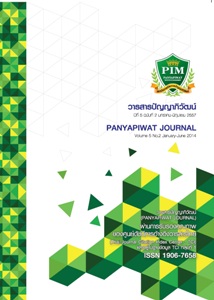สภาวะบ้างาน : สาเหตุ ผลกระทบ และแนวทางการแก้ไข
Main Article Content
บทคัดย่อ
บทคัดย่อ
สภาวะบ้างานเป็นปัจจัยหนึ่งที่สำคัญที่มีการศึกษากันอย่างแพร่หลายในยุคปัจจุบันที่องค์การมีการแข่งขันทางธุรกิจอย่างสูง บุคคลล้วนทำงานหนักเพื่อให้งานของตนและองค์การบรรลุเป้าหมายที่ตั้งไว้ ส่งผลให้ละเลยมิติด้านอื่นๆ ในชีวิตไป ไม่ว่าจะเป็นเวลาพักผ่อน ครอบครัว กีฬา สัน.ทนาการต่างๆ เมื่อบุคคลทำงานหนักเป็นระยะเวลาต่อเนื่องและยาวนานทำให้เกิดปัญหาอื่นๆ ตามมา ไม่ว่าจะเป็นผลการปฏิบัติที่ต่ำกว่ามาตรฐาน สุขภาพกายและใจที่ตกต่ำ ปัญหาครอบครัวที่อาจเกิดขึ้นจากการที่บุคคลละเลย องค์การในฐานะนายจ้างมีส่วนช่วยป้องกันและบรรเทาไม่ให้บุคคลต้องประสบกับสภาวะบ้างาน ซึ่งจะช่วยยกระดับคุณภาพชีวิตของบุคคล และส่งเสริมให้ผลการปฏิบัติงานขององค์การเติบโตต่อไป
Abstract
Workaholic is one of the most important factors that has been studied widely in today's highly competitive business environment. People are working hard to keep their job success and achieve organizational goals, consequently, ignoring the other dimension of life, whether holiday or vacation, family, sports or leisure activities. When people work hard for a long period of continuity causes other problems, not only performing that lower than the standard but also declining mental and physical health, family problems that may occur due to the negligence. Organizations as an employer can prevent and relieve persons who suffer from workaholic. Organization’s support will, therefore, enhance the quality of individuals’ life and encourage the performance of the organization to continue to grow.
Article Details
“ข้าพเจ้าและผู้เขียนร่วม (ถ้ามี) ขอรับรองว่า บทความที่เสนอมานี้ยังไม่เคยได้รับการตีพิมพ์และไม่ได้อยู่ระหว่างกระบวนการพิจารณาลงตีพิมพ์ในวารสารหรือแหล่งเผยแพร่อื่นใด ข้าพเจ้าและผู้เขียนร่วมยอมรับหลักเกณฑ์การพิจารณาต้นฉบับ ทั้งยินยอมให้กองบรรณาธิการมีสิทธิ์พิจารณาและตรวจแก้ต้นฉบับได้ตามที่เห็นสมควร พร้อมนี้ขอมอบลิขสิทธิ์บทความที่ได้รับการตีพิมพ์ให้แก่สถาบันการจัดการปัญญาภิวัฒน์หากมีการฟ้องร้องเรื่องการละเมิดลิขสิทธิ์เกี่ยวกับภาพ กราฟ ข้อความส่วนใดส่วนหนึ่งและ/หรือข้อคิดเห็นที่ปรากฏในบทความข้าพเจ้าและผู้เขียนร่วมยินยอมรับผิดชอบแต่เพียงฝ่ายเดียว”
เอกสารอ้างอิง
Andreassen, C.S., Hetland, J., & Pallesen, S. (2014). Psychometric assessment of workaholism measures. Journal of Managerial Psychology, Vol. 29 No. 1, pp. 7-24.
Aziz, S., & Zickar, M.J. (2006). A cluster analysis investigation of workaholism as a syndrome. Journal of Occupational Health Psychology, 11, 52-62.
Bakker, A.B., Shimazu, A., Demerouti, E., Shimada, K. & Kawakami, N. (2014). Work engagement versus workaholism: A test of the spillover-crossover model. Journal of Managerial Psychology, Vol. 29 No. 1, pp. 63-80.
Beal, D.J., Weiss, H.M., Barros, E. & MacDermid, S.M. (2005). An episodic process model of affective influences on performance. Journal of Applied Psychology, Vol. 90, pp. 1054-1068.
Buelens, M. & Poelmans, S.A.Y. (2004). Enriching the Spence and Robbins, typology of workaholism:Demographic, motivational and organizational correlates. Journal of Organizational Change Management, Vol. 17 No. 5, pp. 440-58.
Burke, R.J. (1999). It's not how hard you work but how you work hard: Evaluating workaholism components. International Journal of Stress Management, 6, 225–39.
Burke, R.J., Matthiesen, S.B., & Pallesen, S. (2006). Personality correlates of workaholism. Personality and Individual Differences, 40, 1223-1233.
Burwell, R. & Chen, C.D.F. (2002). Applying REBT to workaholic clients. Counseling Psychology Quarterly, 15, 219-28.
Douglas, E.J. & Morris R.J. (2006). Workaholic, or just hard worker?. Career Development International,Vol. 11 No. 5, pp. 394-417.
Drago, R. (2000). Trends in working time in the US: A policy perspective. Labor Law Journal, Vol. 51,pp. 212-18.
Gorgievski, M., Bakker, A.B. & Schaufeli, W.B. (2010). Work engagement and workaholism: Comparing the self-employed and salaried employees. Journal of Positive Psychology, Vol. 5, pp. 83-96.
Haas, R. (1991). Strategies to cope with a cultural phenomenon - workaholism. Business and Health,36, 4.
Harpaz, I. (1999). The transformation of work values in Israel: Stability and change over time. Monthly Labor Review, Vol. 122, pp. 46-50.
Killinger, B. (1991). Workaholics: The respectable addicts, Simon & Schuster, New York.
Lee, C., Jamieson, L.F. and Earley, P.C. (1996). Beliefs and fears and type A behavior: Implications for academic performance and psychiatric health disorder symptoms. Journal of Organizational Behavior, 17, 151-78.
McMillan, L.H.W., Brady, E.C., O'Driscoll, M.P. & Marsh, N.V. (2002). A multifaceted study of Spence and Robbins' (1992) workaholism battery. Journal of Occupational and Organizational Psychology, Vol. 75 No. 3, pp. 357-68.
Ng., T.W.H., Sorensen, K.L., & Feldman, D.C. (2007). Dimensions, antecedents, and consequences of workaholism: A conceptual integration and extension. Journal of Organizational Behavior,28, 111-136.
Porter, G. (1996). Organizational impact of workaholism: suggestions for researching the negative outcomes of excessive work. Journal of Occupational Health Psychology, 1, 70-84.
Porter, G. (2004). Work, work ethic, work excess. Journal of Organizational Change Management,17, 424-439.
Robinson, B.E. (1997). Work addiction: Implications for EAP counseling and research. Employee Assistance Quarterly, 12, 1-13.
Robinson, B.E. (2000). A typology of workaholics with implications for counselors. Journal of Addiction & Offender Counselling, Vol. 21 No. 1, pp. 34-48.
Robinson, B.E. (2007). Chained to the desk : A guidebook for workaholics, their partners and children, and the clinicians who treat them. (21 Ed.). New York: New York University Press.
Schabracq, M.J. & Cooper, C.L. (2000). The changing nature of work and stress. Journal of Managerial Psychology, Vol. 15 No. 3, pp. 227-41.
Scott, K.S., Moore, K.S. & Miceli, M.P. (1997). An exploration of the meaning and consequences of workaholism. Human Relations, Vol. 50 No. 3, pp. 287-314.
Seybold, K.C. & Salomone, P.R. (1994). Understanding workaholism: A review of causes and counselling approaches. Journal of Counselling & Development, Vol. 73 No. 1, pp. 4- 9.
Sparks, K., Faragher, E.B., & Cooper, C.L. (2001). Well-being and occupational health in the 21st century workplace. Journal of Occupational and Organizational Psychology, 74, 489-510.
Spence, J.T. & Robbins, A.S. (1992). Workaholism: definition, measurement, and preliminary results. Journal of Personality Assessment, Vol. 58 No. 1, pp. 160-78.
Van den Broeck, A., Schreurs, B., De Witte, H., Vansteenkiste, M., & Germeys, F. (2011). Understanding workaholics' motivations: A self-determination perspective. Applied Psychology: An Inter national Review, 60, 600-621.
Workaholics Anonymous World Service Organization (2006), The Signposts of Workaholism. Retrieved January 3, 2014, from http://www.workaholics-anonymous.org/page.php?page=signposts


